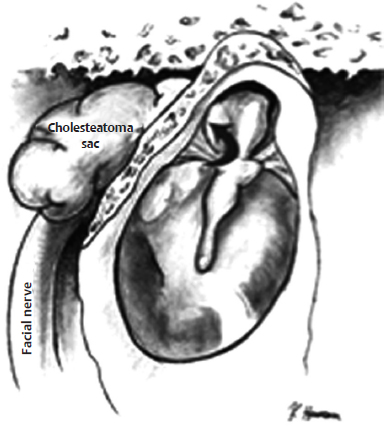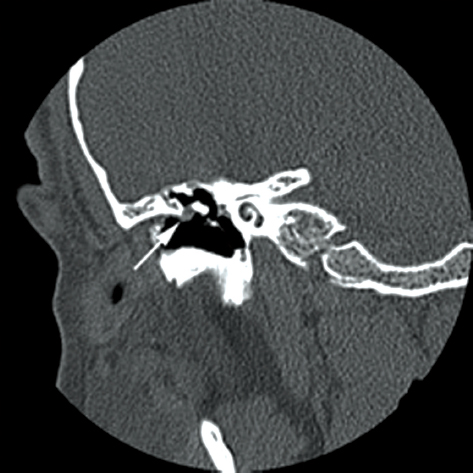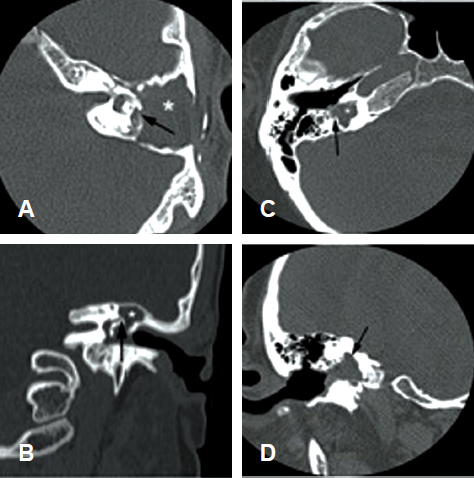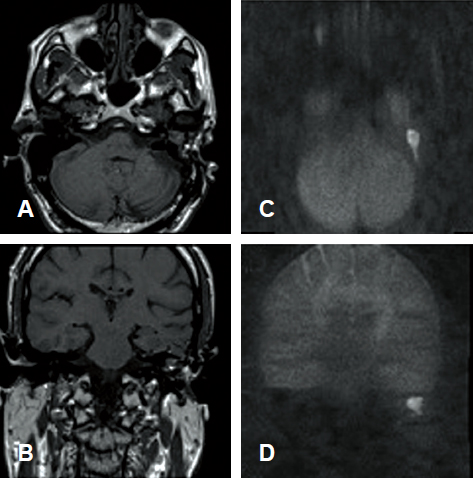16 Cholesteatoma: Causes, Treatment, and Complications
Cholesteatoma causes significant morbidity and rare mortality in the modern era. The term is a misnomer from its microscopic description in the 19th century, because the growth is neither neoplastic nor composed of cholesterol. However, the use of the term persists today. In general, cholesteatoma is an abnormal collection of squamous epithelium within the mucosalized surfaces of the temporal bone: an epidermal cyst. This chapter presents the pathophysiology of cholesteatoma development and the treatment and complications of this disease.
Pathophysiology
Congenital Cholesteatoma
The current criteria for a diagnosis of congenital cholesteatoma are the presence of cholesteatoma behind an intact tympanic membrane and no history of otorrhea, previous perforation, or otologic procedure.1 A history of acute or recurrent otitis media does not exclude the diagnosis given the other criteria are met.2 Several staging systems exist with the two most commonly used described by Nelson et al3 and Potsic et al4 (Table 16.1). Early-stage disease typically involves the anterior-superior quadrant of the tympanic membrane. Late-stage disease can involve the entire middle ear cavity with extension into the mastoid or petrous apex. Early-stage disease has low rates of recurrence (0 to 13%), while advanced disease may recur up to two-thirds of the time.3,4
Significant controversy exists regarding the etiology of this relatively rare entity (2 to 7% of all cholesteatomas).5 The most widely accepted theory currently is that of retained epithelial rests. According to this theory, epithelium that usually resorbs by the 33rd week of gestation persists in the middle ear cleft.2,6 Proliferation of this epithelium results in cholesteatoma formation. These rests have been identified in both prepartum and postpartum specimens, primarily in the anterior-superior quadrant.6,7
Other theories have also been proposed. Abnormal migration of ectodermal tissues from around the tympanic ring results in keratin pearl formation.1 Alternatively, retraction of the tympanic membrane around the malleus handle and umbo may result in microscopic inclusion cysts, which then proliferate to form cholesteatoma.8 Advocates for this inclusion theory of development argue that it accounts for cholesteatoma formation in locations other than the anterior-superior quadrant, which is the only location that epithelial rests have been found in.
Acquired Cholesteatoma
Similar to congenital cholesteatoma, controversy surrounds the exact pathophysiology of acquired cholesteatoma. The most common cause of primary acquired cholesteatoma is a retraction pocket in the tympanic membrane. Although retraction can occur anywhere within the tympanic membrane, the most common location is the pars flaccida. It is postulated that lack of ventilation of the epitympanum and mastoid results in abnormal negative pressures and atelectasis of the relatively weaker pars flaccida and retraction into Prussak space. As the retraction pocket dilates within the epitympanum, the normal process of epithelial desquamation is disrupted and keratin debris accumulates (Fig. 16.1). Definitive evidence of this pathological mechanism was demonstrated in a gerbil model.9
There are several other theories about the development of cholesteatoma. Squamous metaplasia within the middle ear cleft has been identified in patients with chronic otitis media.10 However, it is unclear whether this keratinizing squamous epithelium can form expansile keratin pearls as found in cholesteatoma. Epithelial migration (also known as epithelial ingrowth) may account for a small percentage of perforations.8 According to this theory, perforation or invagination of the tympanic membrane allows for ingrowth of squamous epithelium when the cells loose contact inhibition and then migrate toward the middle ear mucosa.
The exact mechanism by which the conversion between tympanic membrane retraction and cholesteatoma takes place is not clear. It is postulated that bacterial overgrowth and biofilm production induce an inflammatory reaction within the basal layer of the epithelium. The inflammatory process increases cell proliferation in the epithelial tissue, evidenced by increased labeling for Ki-67 and MIB-1,11 resulting in the collection of keratin debris within the sac. In addition to elevated levels of proliferation, cholesteatoma matrix cells have decreased rates of apoptosis. Beyond these cellular responses, biochemical and enzymatic activities, such as elevated matrix metalloproteinases levels causing bony destruction, contribute to the pathological process.
Imaging of Cholesteatoma
Routine imaging, via computed tomography (CT) or magnetic resonance imaging (MRI), of cholesteatoma is not necessary. The diagnosis of cholesteatoma is made on physical examination; however, there are several situations when radiologic imaging can be useful.
Table 16.1 Staging Systems for Congenital Cholesteatoma
Stage | Potsic et al | Nelson et al |
One | Single quadrant, no ossicle or mastoid involvement | Mesotympanum, no incus or stapes erosion |
Two | Multiple quadrants, no ossicle or mastoid involvement | Mesotympanum or attic with ossicular erosion but no mastoid involvement |
Three | Ossicles involved, no mastoid involvement | Mesotympanum and mastoid involvement |
Four | Mastoid involvement | N/A |
N/A, not applicable.
CT of the temporal bone is very helpful in delineating bony anatomy. An attic cholesteatoma may be successfully treated via an atticotomy (see “Atticotomy” under “Treatment”) CT is helpful in this situation to define the extent of the disease and confirm the physical examination findings. If the cholesteatoma extends outside the attic on imaging, then another surgical approach is more appropriate (Fig. 16.2). Bony imaging is also useful if there is suspicion for a fistula (see below). Patients presenting with Tullio phenomenon, positive fistula test, or severe sensorineural hearing loss may have disease extension into the labyrinth. Erosion into the otic capsule can be seen on CT (Fig. 16.3). However, the surgeon should be aware that some patients with small fistulae will be asymptomatic. Finally, CT imaging is useful in patients with recurrent disease. This is particularly true when the patient was previously operated on by another surgeon. CT can help identify bony landmarks used in surgery and help guide surgical decision making.
Figure 16.1 Proposed pathophysiology of acquired cholesteatoma. Negative pressure within the middle ear cleft results in retraction of the relatively weaker pars flaccida (arrow). Collection of desquamated keratin debris results in inflammation of and increased cell turnover within the sac.
In contradistinction to CT, MRI provides excellent soft-tissue detail but poor bony anatomy. In patients who have undergone subtotal petrosectomy with ear canal closure, MRI can be used to identify cholesteatoma. Recently, a heavily T2-weighted imaging sequence known as HASTE has been used to identify cholesteatoma.12 The premise behind this sequence is that water within surrounding tissues can diffuse away after excitation while the water within the cholesteatoma cannot. Thus, the cholesteatoma is hyperintense on this sequence (Fig. 16.4).
Treatment
The presence of a retraction pocket is not necessarily an indication for operation. A clean, dry retraction pocket that does not drain can be monitored in the reliable patient. However, if the pocket begins to collect keratin and cannot be examined easily or the patient is unreliable, surgical intervention is warranted. The goal of any operation for cholesteatoma is to create a dry and safe ear, an ear that does not reaccumulate keratin, spontaneously drain, or put the patient at risk for infectious complications. Hearing restoration, while desirable, is a secondary goal. A full discussion of the technical aspects of each of procedures described below is beyond the scope of this chapter. The indications for and a brief description of these procedures are reviewed: atticotomy, canal wall up mastoidectomy, canal wall down mastoidectomy, and canal wall reconstruction mastoidectomy.
Figure 16.2 Attic cholesteatoma. Coronal computed tomography of a right ear cholesteatoma. The sac is limited to Prussak space (arrow). This disease is amenable to an atticotomy.
Figure 16.4 HASTE sequence magnetic resonance imaging (MRI). The patient had a subtotal petrosectomy and ear canal closure for cholesteatosis after a temporal bone fracture as a teenager. The HASTE image identifies recurrent disease within the mastoid that was confirmed at surgery. (A and B) T1 noncontrast axial (A) and coronal (B) images at the level of the internal auditory canal. Soft-tissue density within the surgical bed is present; however, it cannot be distinguished from recurrent cholesteatoma. (C and D) Nonspin diffusion-weighted MRI (HASTE) in the axial (C) and coronal (D) planes. The recurrent cholesteatoma is hyperintense when compared with surrounding structures, including brain.
Atticotomy
Atticotomy provides access to the epitymanic (attic) space while maintaining the structure of the lateral canal wall and tympanic membrane. Candidates for this procedure have disease limited to the anterior epitympanic space (Prussak space) with no extension into the additus ad antrum and mastoid. In this procedure, the scutum is removed to the limits of the cholesteatoma sac. If the sac extends beyond the attic, the procedure must be converted to a canal wall down procedure (described below). The scutal defect must be reconstructed at the end of the case.
The procedure may be accomplished via an endaural or postauricular incision. The procedure begins with standard vascular strip incisions of the ear canal skin and elevation of a tympanomeatal flap. Small diamond drills are used to remove the scutum to expose the entire sac. The sac is excised and the bony defect is then reconstructed with a cartilage graft or a small bone chip. The tympanomeatal and vascular strip flaps are then returned to position, and the ear canal is packed with absorbable gelatin sponge.
Canal Wall Up Mastoidectomy
Exploration of the mastoid should be considered in a variety of situations: cholesteatoma extending beyond the attic space, inability to clear middle ear disease via tympanoplasty alone, and draining infectious complications of chronic otitis media and cholesteatoma. Generally, mastoid surgery begins as a canal wall up procedure that can then be converted, if necessary.
The procedure is begun with a postauricular incision. The mastoid cortex is removed beginning parallel to the inferior temporal line. The limits of dissection are the tegmen tympani, the posterior external auditory canal, and the sigmoid sinus. The petrosquamous suture is encountered before entering the antrum of the mastoid and is referred to as Koerner septum. Once the septum is penetrated, the bony trabeculae are removed.
Stay updated, free articles. Join our Telegram channel

Full access? Get Clinical Tree






